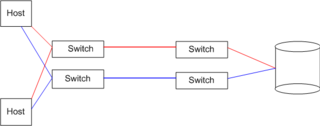Fibre Channel


In the Fibre Channel Switched Fabric (FC-SW-6) topology, devices are connected through one or more Fibre Channel switches. While this topology has the best scalability of the three FC topologies (the other two are Arbitrated Loop and point-to-point), [2] it is the only one requiring switches, which are costly hardware devices.
Visibility among devices (called nodes) in a fabric is typically controlled with Fibre Channel zoning.
Multiple switches in a fabric usually form a mesh network, with devices being on the "edges" ("leaves") of the mesh. Most Fibre Channel network designs employ two separate fabrics for redundancy. The two fabrics share the edge nodes (devices), but are otherwise unconnected. One of the advantages of such a setup is the capability of failover, meaning that in case one link breaks or a fabric goes out of order, datagrams can be sent via the second fabric.
The fabric topology allows the connection of up to the theoretical maximum of about 16 million devices, limited only by the available address space (224).
239 domains * 256 areas * 256 ports = 15,663,104 [3]